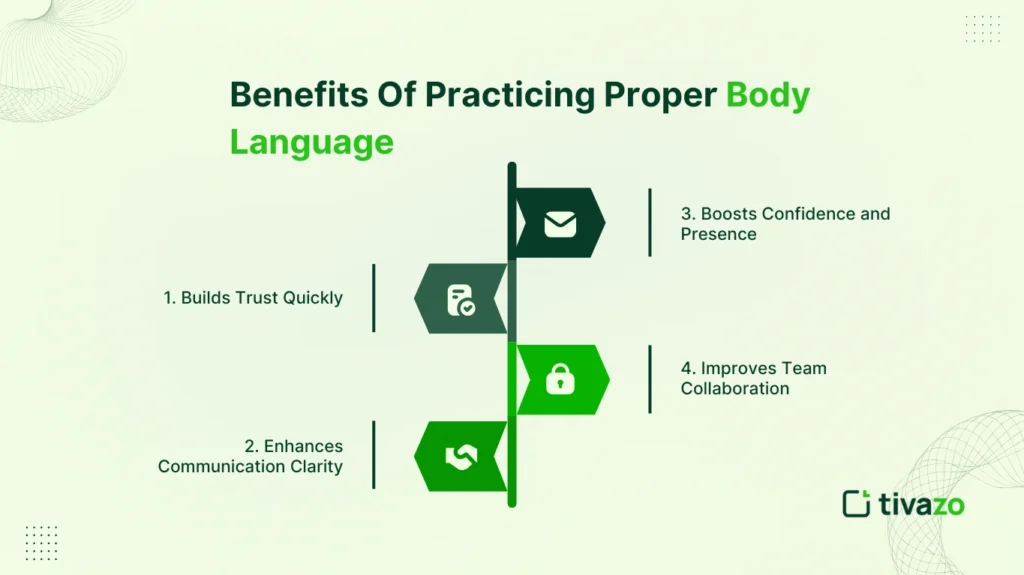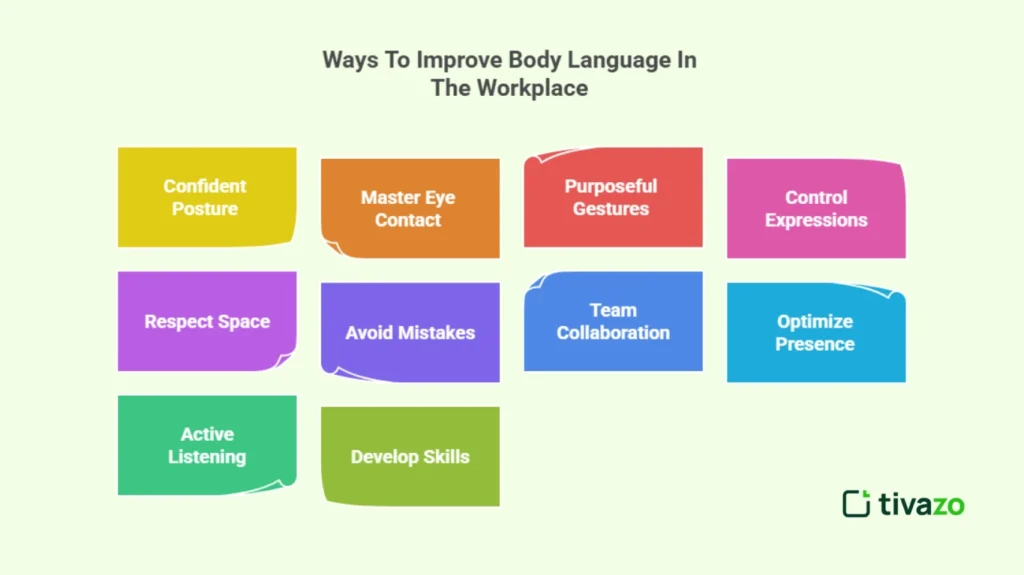Body language in the workplace is a silent language that can speak volumes about your confidence, professionalism, and approachability. Communicative gestures, such as postures, facial expressions, and gestures in general, tend to influence other colleagues as well as leaders’ perception of you more than your words.
Learning and using professional body language will improve communication within a workplace environment, make teamwork easier, and develop trust. The secret to collaboration and career development can be as small as looking into a person in the eyes during meetings or trying to open positions to demonstrate interest. Mainly, this leads to misinterpretations and missed chances, stemming from ignoring such signals.
Effective communication in the present busy working life is not just enough talking. Nonverbal communication is a major constituent of communication in the delivery and reception of messages. Being aware of the effects of facial expressions and gestures can enhance interpersonal relations as well as leadership delivery. The presented article dwells upon the influence of body language in the workplace and presents practical suggestions to enhance your professional performance.
Key Highlights:
- Benefits Of Practicing Proper Body Language
- 10 Ways To Improve Body Language In The Workplace
- Body Language by Role: Managers vs. Employees
- Gender and Cultural Differences in Workplace Body Language
What is Body Language?
Body language in the workplace refers to the nonverbal signals we use to communicate, including facial expressions, gestures, posture, and eye contact. It is an essential element of professional body language that expresses feelings and intentions other than the verbal ones. The knowledge of these gestures, which include confident body language, personal space, and facial expressions, can better communication at the workplace, develop trust, and foster collaboration. When you have mastered body language, it improves your presence and effectiveness as a professional person.
Benefits Of Practicing Proper Body Language
Using proper body language in the workplace can drastically improve your relationships and communication with everyone you work with. Getting nonverbal communication down will help you cultivate trust with your co-workers and clients, as well as help convey confidence.

1. Builds Trust Quickly
It’s important to establish your trustworthiness through body language in the workplace. If colleagues are using nonverbal cues consistently that express positive intentions, consistent nonverbal behaviors such as good eye contact, smiles, keeping your stance open and approachable, or communicating positive responses when appropriate, indicate that you are being honest and trustworthy conversationally. When colleagues feel comfortable accepting that your nonverbal communication is consistent and true (which are highly valuable attributes in the workplace), you can easily build on each interaction and initiate effective communication based on trust and respect.
Establishing proper body language in the workplace builds trust can reduces miscommunication, but also fosters collaboration with employees. When you present yourself well with confident body language that outwardly states you are approachable, it encourages collaboration and teamwork more easily and ultimately gets more done and increases productivity.
Being successful at gaining trust through proper body language is a key factor in the success of your career, and people in the workplace building relationships.
2. Enhances Communication Clarity
Proper body language in the workplace assists communication with clarity: Nonverbal signals reinforce and complement the verbal gestures used with speech and other verbal communication tactics. Many gestures, facial expressions, and other ways to use the human body can be piled on top of one another or used at the same time. Good body language in the workplace can work with words to give emphasis on the intention you are seeking when expressing your ideas. Balancing verbal with nonverbal communication can further reduce confusion in places of employment and better convey your ideas.
Misaligned body language, on the other hand, can create mixed signals that lead to misunderstandings. Mastering nonverbal communication helps you avoid these pitfalls, making your workplace interactions more effective and your professional presence stronger.
3. Boosts Confidence and Presence
In a work atmosphere, you can establish your confident body language in the workplace through gestures, standing tall, and purposeful movements. Your body language affects how you are perceived in a professional context, as it conveys competent self-confidence and enhances your professional image. Not only does having a great presence make you stand out at meetings, but presentations, and interactions at the workplace too.
When you feel confident, you naturally display your body language in a confident manner, which enhances the positive feedback loop, creating optimism and lowering inhibitions. Your confidence provides personal benefits but also inspires trust and confidence from those in both leadership and collegial positions alike.
4. Improves Team Collaboration
Positive body language in the workplace creates a productive teamwork environment. Positive body language in the workplace supports team cohesion through communication, collaboration, and trust. Nodding, smiling, and eye contact show your colleague that you are genuinely listening and are engaging in a respectful manner. These observations tell someone that you are respecting their communication and thereby encourage their involvement and sharing their views.
The more inclusive, collaborative, and supportive your nonverbal communication, the more you create a basis for interpersonal connections and reduce workplace conflict. When a more supportive environment exists, individuals can be more productive and collaborate on achieving a common team goal.
Improper or deficient body language in the workplace not only negatively impacts your daily work life experiences but also establishes barriers to your future career prospects.
10 Ways To Improve Body Language In The Workplace
Enhancing your body language in the workplace will not only help make communication become effective but also help achieve successful contact with other people in the working environment. Minor changes in these three areas: posture, eye contact, and gestures, can greatly change the way your message is perceived and how sure of yourself you can be.

1. Adopt a Confident Posture
The body language in the workplace involves your posture. An upright, open way of standing or of sitting conveys confidence and authority. Walden University accounts that even your confidence can be advanced while standing in power poses, i.e., in broad, expansive positions, because of the effects they have on hormone levels dealing with stress and dominance.
Stop slouching and turn inward, which would make you appear aloof or unconfident. Rather, maintain a straight back, raised chin, and more or less on your feet. This minor change helps you to look and feel more confident.
2. Master Eye Contact
Eye contact is one of the pivots of body language in the workplace. Sustaining a level, natural eye contact in the process of a conversation indicates confidence and sincerity. But it is all about moderation, as it can come across as an aversion in excess and as elusive when done in small increments.
The de-escalation training states that proper eye contact can be used for rapport formation and active listening. About 50-70 percent of eye contact should be achieved when communicating with employees or customers to ensure that they do not feel uncomfortable, as they will be engaged.
3. Use Purposeful Gestures
Non-verbal gestures will help you to better convey what you are saying through the use of hand movements to express important points and also show enthusiasm. Gestures are common with politicians and people making speeches as they employ them to capture their listeners.
Fidgets too much or too overtly, however, such as finger tapping, winching of the facial muscles, and the like, are detrimental to your message as they send the message of nervousness. Business.com cautions on placing the hand awkwardly, like the fig leaf pose that portrays insecurity.
4. Control Facial Expressions
The most expressive part of your body language is your face. It sends open and approachable messages by smiling, nodding, and having a relaxed expression on the face. Based on the study by Paul Ekman, as listed by Walden University, there are seven universal emotions identified when one interprets a facial expression, which may either support or reject what you are saying.
Where dissimilar language would be a non-smile when one says something positive or a serious brow when one says something nice, such a mixed message can be mistaken and can lessen credibility.
5. Respect Personal Space
There is a need to understand proxemics, which is the application of personal space, to take place in a diversified work environment. When you invade his/her comfort zone, that would make them uncomfortable, whereas being too far makes them disinterested.

Brandeis University emphasizes that different people belong to different cultures that have various preferences concerning personal space. To cite an example, proximity can be normal in some Latin American countries and intrusive in Northern Europe. Misunderstandings can be avoided by being culturally conscious and flexible.
6. Avoid Common Mistakes
Certain unintentional nonverbal cues have the capability of delivering the wrong message. Business.com reveals the main mistakes, such as lack of consistency in some messages (when your body is telling something different from what you are saying), slouched bodies, folded arms, and lack of attentiveness (looking at a watch, or rolling of the eyes).
The next step to get better is to check your body language yourself on a regular basis and ask some colleagues you trust how you are coming across. Being mindful of your nonverbal communication truly makes a difference in the workplace communication.
7. Encourage Team Collaboration
The good body language in the workplace promotes forthcoming communication and team collaborations. Leaning leadings in, nods, and smiles show the signs of attention and agreement. In Deescalation Training, such indications minimize the tension, eliminate the possibility of a misunderstanding, and enhance the motivation of a team.
Mirror the body language in the workplace in subtle ways: it will generate a feeling and a sense of empathy, which will allow establishing better relationships.
8. Optimize Meeting Presence
The meaning behind the body language in meetings could either destroy the message or create one. Be tall, have open hands, and make eye contact in order to command attention. Bad posture, such as the one associated with crossed arms, should be avoided.
Try not to hide behind your camera during a virtual meeting, make sure you have a view of your upper body and your face visible, so that your gestures and your expressions can be read. Simple gestures, such as nodding to show interest as people are talking, make a difference even when there is a screen present.
9. Practice Active Listening
Listening is more than listening with your ears, but rather demonstrating your interest with body language in the workplace. To show understanding, remain in eye contact, nod every now and then, and in short facial expressions.
Avoid distraction, too, such as looking away or fussing, as an indicator of a lack of interest. Indeed.com reiterates that careful body language helps to establish better interpersonal relationships and enhance communication in the workplace.
10. Develop Body Language Skills Regularly
Good body language takes time, just as any other skill ought to. You can improve your levels of awareness and mastery of nonverbal cues by using role-playing situations, taping yourself as you make presentations, and getting professional coaching.
It has been observed that training programs involving awareness of body language enhance workplace confidence and presence of leaders, as observed by a number of experts.
With repeated application of each of these 10 strategies, you will start communicating more nonverbally, build trust, and make your workplace more positive.
Body Language by Role: Managers vs. Employees
Understanding how to use body language in the workplace effectively depends on your role. A manager’s nonverbal cues can shape team culture, while employees can use theirs to build credibility and trust.
For Managers and Leaders
Leaders set the tone through their presence. Strong, confident posture combined with approachable gestures helps project authority without intimidation. Making consistent eye contact, actively nodding, and keeping an open stance signals that you’re engaged and receptive. Avoiding crossed arms or looking away during conversations prevents the impression of disinterest or defensiveness.
Positive body language in the workplace from leaders fosters psychological safety. It encourages team members to speak up, share ideas, and feel valued, leading to higher engagement and productivity.
For Employees and Team Members
Employees can strengthen their professional image by using respectful, confident body language. Sitting upright in meetings, offering firm (but not aggressive) gestures, and showing attentiveness with facial expressions and eye contact reflect reliability and confidence. Mirroring the body language of your manager subtly can also build rapport.
In high-pressure environments, calm and controlled body language in the workplace helps demonstrate resilience and composure—qualities that often lead to leadership opportunities.
Gender and Cultural Differences in Workplace Body Language
The meaning of body language in the workplace varies with both culture and gender. What we think of as assertive in one situation is thought of as pushy or rude in another. Being aware of these differences is the key to communicating better, misunderstandings people, and encouraging inclusivity in the workplace.
Gender-Based Differences
Studies indicate that men and women usually interpret as well as express their body language divergently in the workplace. As a good example, men can assume broad poses or fewer facial expressions as an expression of dominance. Instead, women are more likely to appeal to eye contact, nodding, and gestures of expression, which might be seen as signs of warmth or agreement, even when not directed.
The differences may be a source of bias. As an example, confidence used as a body language by women can be countered as aggressiveness, whereas the same by men can be interpreted as effective leadership. The knowledge of these biases assists in creating a more equal and respectful workplace.
Cultural Differences
The norm in body language is determined by cultural background. Indirect gaze to authority figures may be an expected way of behavior in some East Asian cultures, whereas directly staring at authority figures characterizes the confident and attentive style in Western cultures. Reigning differences in personal spaces differ as well- Latin Americans and Middle Easterners may relate intimately during discussions, but someone originating in the North European region may like the more distanced space.
Gestures may be even more complicated. The expression of thumbs-up may be positive in most of the Western nations but is insulting in some areas of the Middle East and South America.
Conclusion
Body language in the workplace is a powerful form of communication that influences how others perceive you and how effectively you connect with your colleagues. By adopting confident postures, mastering eye contact, using purposeful gestures, and respecting cultural differences, you can enhance your professional presence significantly.
Are you ready to start reading beyond words and transform your workplace interactions with the power of body language?
FAQ’s
What is negative body language in the workplace?
Negative body language includes crossed arms, avoiding eye contact, slouching, fidgeting, and facial expressions like eye-rolling, which can signal disinterest, defensiveness, or disrespect.
What are unacceptable behaviors at work?
Unacceptable behaviors include disrespectful gestures, invading personal space, aggressive postures, interrupting others, and any nonverbal cues that create discomfort or hostility.
What does disrespect look like in the workplace?
Disrespect in the workplace can appear as dismissive gestures, ignoring colleagues, avoiding eye contact, sarcastic facial expressions, or body language that belittles or undermines others.




